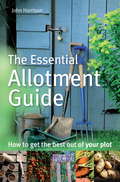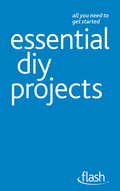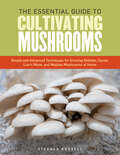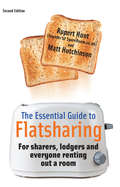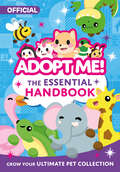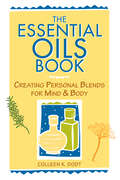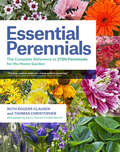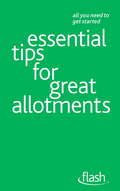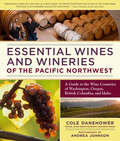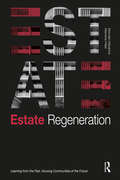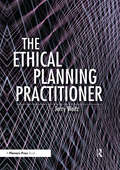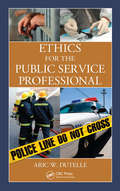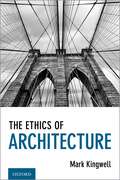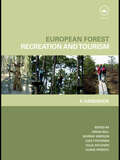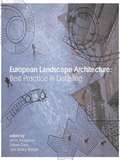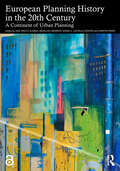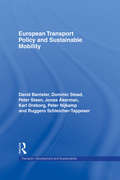- Table View
- List View
The Essential Allotment Guide: How to Get the Best out of Your Plot
by John HarrisonIn recent years allotments have grown in popularity with demand far outstripping supply. John Harrison shows how to improve your chances of getting an allotment and move up the waiting list. In this all-encompassing guide, he also advises on clearing an allotment, planning what to grow and how, building compost bins, using raised beds - plus detailed instructions on growing the best vegetables and fruit.Praise for John Harrison's Vegetable Growing Month by Month:"...solid words of advice, written in a way that everyone will understand."Medwyn Williams, Chairman of the National Vegetable Society and member of the Fruit and Vegetable Committee of the Royal Horticultural Society.
Essential DIY Projects: Flash (Flash)
by DIY DoctorThe books in this bite-sized new series contain no complicated techniques or tricky materials, making them ideal for the busy, the time-pressured or the merely curious. Essential DIY Projects is a short, simple and to-the-point guide to that will teach you a number of essential projects around the house in just 96 pages. Suitable even for those who've never picked up a hammer, this is an ideal starting point for the new home-owner or tentative DIY-er.
The Essential Guide to Cultivating Mushrooms: Simple and Advanced Techniques for Growing Shiitake, Oyster, Lion's Mane, and Maitake Mushrooms at Home
by Stephen RussellWith clear instructions and step-by-step photographs, this straightforward guide shows you how to cultivate mushrooms in your own home.
The Essential Guide To Flatsharing, 2nd Edition: For sharers, lodgers and everyone renting out a room
by Matt Hutchinson Rupert HuntWhether you're looking for a flatshare or renting out a room The Essential Guide to Flatsharing has everything you need to know. If you're: * Renting out a spare room. * All about taking in a lodger; drawing contracts; the tax and financial issues; necessary preparation; advertising your room; and much more. * Looking for a flatshare. * Where to look; how to pick the best flatmates; how to keep your flatshare harmonious; how to avoid conflicts. * Finding a new flatmate. *How to advertise; picking the right person; dealing with money.
The Essential Handbook (Adopt Me!)
by Uplift GamesAn essential game companion for new players and long-time fans of the popular online game, Adopt Me!
The Essential Oils Book: Creating Personal Blends for Mind & Body
by Colleen K. DodtDiscover the fragrant world of essential oils. Herbalist Colleen K. Dodt profiles the healing and cleaning powers of dozens of oils extracted from herbs, flowers, roots, barks, and resins. This comprehensive guide includes recipes for natural cleaning products, lotions, and ointments that will keep you feeling happy and smelling great. Fill your days with stimulating scents as you learn to use essential oils to wash your dishes, soothe sunburns, combat stress, and improve the quality of your life.
Essential Perennials: The Complete Reference to 2700 Perennials for the Home Garden
by Ruth Rogers Clausen Thomas ChristopherPerennials—herbaceous plants that go dormant in the fall and then return in the spring—are the main fabric of any ornamental garden. With Essential Perennials, gardeners of all levels can cultivate a home garden lush with enduring colors, rhythms, and forms.
Essential Tips for Great Allotments: All You Need To Get Started (Flash)
by Geoff StokesThe books in this bite-sized new series contain no complicated techniques or tricky materials, making them ideal for the busy, the time-pressured or the merely curious. Essential Tips for Great Allotments: Flash is a short, simple and to-the-point guide that will teach you all the fundamentals for your allotment, from what tools to use to which crops to grow in just 96 pages. For those new to allotments, this is an ideal starting point for growing your own produce organically.
Essential Wines and Wineries of the Pacific Northwest: A Guide to the Wine Countries of Washington, Oregon, British Columbia, and Idaho
by Cole DanehowerSuperbly balanced pinot noirs; crisp rieslings; rich, heady syrahs: these are only a fraction of the expertly crafted wines being produced in the Pacific Northwest's diverse and distinctive wine countries. Second only to California in production, the Pacific Northwest is the largest wine region in North America, home to more than 1,000 wineries. What was once a young wine-growing area with a reputation for eccentricity is today recognized as a dynamic region producing world-class wines, with a focus on ecologically sound practices.This definitive volume profiles the wines, the people who make them, and the wine countries of Washington, Oregon, British Columbia, and Idaho. The journey begins with the region's climates and geology, which create a fascinating tapestry of wine-growing areas. Next, the book focuses on the unique qualities of each wine region, with profiles of more than 160 representative wineries to visit. Included are legacy wineries that helped to build the region’s reputation, prestige wineries with a national presence, under-the-radar artisan wineries that embody the pioneering spirit of the Northwest, and promising new wineries. Each profile lists the winery's signature, premium, value, and estate wines.Beautifully illustrated with photographs and helpful maps, this in-depth guide is a milestone in the North American literature on wine. It will enable wine lovers everywhere to plan their touring, select their wines, and explore and discover the riches of the Northwest's wine country.
Estate Regeneration: Learning from the Past, Housing Communities of the Future
by Brendan Kilpatrick Manisha PatelOne hundred years ago, the Addison Act created the circumstances for the large scale construction of municipal housing in the UK. This would lead to the most prolific phases of housing estate building the country has ever seen. The legacy of this historic period has been tackled for the last twenty-five years as these estates began to suffer from misguided allocation policies, systemic building and fabric failure and financial austerity. A series of estate regeneration programmes sought to rectify the mistakes of the past. Estate Regeneration describes 24 of these regeneration schemes from across the UK and the design philosophy and resident engagement which formed each new community. A number of essays from a wide range of industry experts amplify the learning experience from some key estate regeneration initiatives and provide observations on the broader issues of this sector of the housing market. Regeneration is inevitable; it is a matter of the form which regeneration should take. The information presented here is a guide to an intuitive approach to estate regeneration which commences with the derivation of strong urban design principles and is guided by real community engagement. The experience presented seeks to learn from the mistakes of the past to create the best possible platform for regeneration of the housing estates of the future.
Estate Regeneration: Learning from the Past, Housing Communities of the Future
by Brendan Kilpatrick Manisha PatelOne hundred years ago, the Addison Act created the circumstances for the large scale construction of municipal housing in the UK. This would lead to the most prolific phases of housing estate building the country has ever seen. The legacy of this historic period has been tackled for the last twenty-five years as these estates began to suffer from misguided allocation policies, systemic building and fabric failure and financial austerity. A series of estate regeneration programmes sought to rectify the mistakes of the past. Estate Regeneration describes 24 of these regeneration schemes from across the UK and the design philosophy and resident engagement which formed each new community. A number of essays from a wide range of industry experts amplify the learning experience from some key estate regeneration initiatives and provide observations on the broader issues of this sector of the housing market. Regeneration is inevitable; it is a matter of the form which regeneration should take. The information presented here is a guide to an intuitive approach to estate regeneration which commences with the derivation of strong urban design principles and is guided by real community engagement. The experience presented seeks to learn from the mistakes of the past to create the best possible platform for regeneration of the housing estates of the future.
Ethical Planning Practitioner
by Jerry WeitzIf a local college gives a city planner tickets to a sold-out football game, is it wrong to take them – even if the planner pays? Should a planning consultant bid on a project that has a clearly unrealistic timeframe? Can a planning director moonlight for another agency? For practicing planners, potential ethics violations abound, and the eye of public scrutiny never blinks. Planners need a guide, and now they have it: the first guidebook based on the current revision of the AICP (American Institute of Certified Planners) Code of Ethics and Professional Conduct. The Ethical Planning Practitioner presents 76 scenarios, all real-life dilemmas based on the code's rules of conduct. Each scenario comes with tools to help planners explore the answers on their own, in a training session, or in a classroom. This vital handbook looks at everyday ethics the way planners need to see them, in black, white, and shades of gray – but most of all, clearly. It will not only instruct but inspire planners to strengthen the public's trust.
Ethical Planning Practitioner
by Jerry WeitzIf a local college gives a city planner tickets to a sold-out football game, is it wrong to take them – even if the planner pays? Should a planning consultant bid on a project that has a clearly unrealistic timeframe? Can a planning director moonlight for another agency? For practicing planners, potential ethics violations abound, and the eye of public scrutiny never blinks. Planners need a guide, and now they have it: the first guidebook based on the current revision of the AICP (American Institute of Certified Planners) Code of Ethics and Professional Conduct. The Ethical Planning Practitioner presents 76 scenarios, all real-life dilemmas based on the code's rules of conduct. Each scenario comes with tools to help planners explore the answers on their own, in a training session, or in a classroom. This vital handbook looks at everyday ethics the way planners need to see them, in black, white, and shades of gray – but most of all, clearly. It will not only instruct but inspire planners to strengthen the public's trust.
Ethics for the Public Service Professional
by Aric W. DutellePublic service professionals � government officials, those in the legal system, first responders, and investigators � confront ethical issues every day. In an environment where each decision can mean the difference between life and death or freedom and imprisonment, deciding on an ethical course of action can pose challenges to even the most season
The Ethics of Architecture
by Mark KingwellA lively and accessible discussion of how architecture functions in a complex world of obligation and responsibility, with a preface offering specific discussion of architecture during and after the COVID-19 pandemic. What are the special ethical obligations assumed by architects? Because their work creates the basic material conditions that make all other human activity possible, architects and their associates in building enjoy vast influence on how we all live, work, play, worship, and think. With this influence comes tremendous, and not always examined, responsibility. This book addresses the range of ethical issues that architects face, with a broad understanding of ethics. Beyond strictly professional duties - transparency, technical competence, fair trading - lie more profound issues that move into aesthetic, political, and existential realms. Does an architect have a duty to create art, if not always beautiful art? Should an architect feel obliged to serve a community and not just a client? Is justice a possible orientation for architectural practice? Is there such a thing as feeling compelled to "shelter being" in architectural work? By taking these usually abstract questions into the region of physical creation, the book attempts a reformulation of "architectural ethics" as a matter of deep reflection on the architect's role as both citizen and caretaker. Thinkers and makers discussed include Le Corbusier, Martin Heidegger, Lewis Mumford, Rem Koolhaas, Jane Jacobs, Arthur Danto, and John Rawls.
The Ethics of Architecture
by Mark KingwellA lively and accessible discussion of how architecture functions in a complex world of obligation and responsibility, with a preface offering specific discussion of architecture during and after the COVID-19 pandemic. What are the special ethical obligations assumed by architects? Because their work creates the basic material conditions that make all other human activity possible, architects and their associates in building enjoy vast influence on how we all live, work, play, worship, and think. With this influence comes tremendous, and not always examined, responsibility. This book addresses the range of ethical issues that architects face, with a broad understanding of ethics. Beyond strictly professional duties - transparency, technical competence, fair trading - lie more profound issues that move into aesthetic, political, and existential realms. Does an architect have a duty to create art, if not always beautiful art? Should an architect feel obliged to serve a community and not just a client? Is justice a possible orientation for architectural practice? Is there such a thing as feeling compelled to "shelter being" in architectural work? By taking these usually abstract questions into the region of physical creation, the book attempts a reformulation of "architectural ethics" as a matter of deep reflection on the architect's role as both citizen and caretaker. Thinkers and makers discussed include Le Corbusier, Martin Heidegger, Lewis Mumford, Rem Koolhaas, Jane Jacobs, Arthur Danto, and John Rawls.
European Forest Recreation and Tourism: A Handbook
by Simon Bell Murray Simpson Liisa Tyrväinen Tuija Sievänen Ulrike PröbstlIn an increasingly urbanized world more and more people are turning to our forests and woodland for recreation and tourism. Planning and providing for this growing demand poses challenges that need to be addressed by managers and designers alike. Based on a study of forest recreation from across Europe, the editors bring together the expertise of more than eighty leading professionals and academics to provide a clear and concise guide to best practice. Case studies and careful research give a detailed insight into the issues that forest recreation raises, from strategic planning to integration into the existing rural economy. Essential reading for tourism planners, landscape designers and countryside managers delivering forest recreation and tourism.
European Forest Recreation and Tourism: A Handbook
by Simon Bell Murray Simpson Lisa Tyrväinen Tuija Sievänen Ulrike PröbstlIn an increasingly urbanized world more and more people are turning to our forests and woodland for recreation and tourism. Planning and providing for this growing demand poses challenges that need to be addressed by managers and designers alike. Based on a study of forest recreation from across Europe, the editors bring together the expertise of more than eighty leading professionals and academics to provide a clear and concise guide to best practice. Case studies and careful research give a detailed insight into the issues that forest recreation raises, from strategic planning to integration into the existing rural economy. Essential reading for tourism planners, landscape designers and countryside managers delivering forest recreation and tourism.
European Landscape Architecture: Best Practice in Detailing
by Ian Thompson Torben Dam Jens Balsby NielsenDrawing together case studies from all over Europe, this text explores the relationship between the overall idea of the landscape architecture for a site and the design of details. Examining concept sketches and design development drawings in relation to the details of the design, the book offers a more profound understanding of decision making through all stages of the design process. The book includes the study of the choice of materials and techniques of construction, and explores the cultural and symbolic significance of such choices, as well as questions of environmental sustainability. With projects analyzed and evaluated here that have won international acclaim, or have been awarded national prizes, European Landscape Architecture is a core book in the study and understanding of the subject.
European Landscape Architecture: Best Practice in Detailing
by Ian H. Thompson Torben Dam Jens Balsby NielsonDrawing together case studies from all over Europe, this text explores the relationship between the overall idea of the landscape architecture for a site and the design of details. Examining concept sketches and design development drawings in relation to the details of the design, the book offers a more profound understanding of decision making through all stages of the design process. The book includes the study of the choice of materials and techniques of construction, and explores the cultural and symbolic significance of such choices, as well as questions of environmental sustainability. With projects analyzed and evaluated here that have won international acclaim, or have been awarded national prizes, European Landscape Architecture is a core book in the study and understanding of the subject.
European Planning History in the 20th Century: A Continent of Urban Planning
by Max Welch Guerra Abdellah Abarkan Castrillo Romón, María A. Martin Pekár Victoria GrauThe history of Europe in the 20th century is closely tied to the history of urban planning. Social and economic progress but also the brute treatment of people and nature throughout Europe were possible due to the use of urban planning and the other levels of spatial planning. Thereby, planning has constituted itself in Europe as an international subject. Since its emergence, through intense exchange but also competition, despite country differences, planning has developed as a European field of practice and scientific discipline. Planning is here much more than the addition of individual histories; however, historiography has treated this history very selective regarding geography and content. This book searches for an understanding of the historiography of planning in a European dimension. Scholars from Eastern and Western, Southern and Northern Europe address the issues of the public led production of city and the social functions of urban planning in capitalist and state-socialist countries. The examined examples include Poland and USSR, Czech Republic and Slovakia, UK, Netherlands, Germany, France, Portugal and Spain, Italy, and Sweden. The book will be of interest to students and scholars for Urbanism, Urban/Town Planning, Spatial Planning, Spatial Politics, Urban Development, Urban Policies, Planning History and European History of the 20th Century.
European Planning History in the 20th Century: A Continent of Urban Planning
by Max Welch Guerra Abdellah Abarkan María A. Castrillo Romón Martin PekárThe history of Europe in the 20th century is closely tied to the history of urban planning. Social and economic progress but also the brute treatment of people and nature throughout Europe were possible due to the use of urban planning and the other levels of spatial planning. Thereby, planning has constituted itself in Europe as an international subject. Since its emergence, through intense exchange but also competition, despite country differences, planning has developed as a European field of practice and scientific discipline. Planning is here much more than the addition of individual histories; however, historiography has treated this history very selective regarding geography and content. This book searches for an understanding of the historiography of planning in a European dimension. Scholars from Eastern and Western, Southern and Northern Europe address the issues of the public led production of city and the social functions of urban planning in capitalist and state-socialist countries. The examined examples include Poland and USSR, Czech Republic and Slovakia, UK, Netherlands, Germany, France, Portugal and Spain, Italy, and Sweden. The book will be of interest to students and scholars for Urbanism, Urban/Town Planning, Spatial Planning, Spatial Politics, Urban Development, Urban Policies, Planning History and European History of the 20th Century.
European Transport Policy and Sustainable Mobility (Transport, Development and Sustainability Series)
by Jonas Akerman David Banister Karl Dreborg Peter Nijkamp Ruggero Schleicher-Tappeser Dominic Stead Peter SteenIt is now widely accepted that transport is becoming increasingly unsustainable and that strong policy intervention is required to reduce both the growth in transport demand and the environmental costs of transport. This book challenges conventional approaches to transport by moving away from trend based analysis towards the use of scenarios to identify alternative sustainable transport futures. It both summaries the development of EU transport policy and presents a critique. The policy context is widened to include the global changes taking place in economics, society and technology. It develops new methodologies for policy making for the next 25 years.
European Transport Policy and Sustainable Mobility (Transport, Development and Sustainability Series)
by Jonas Akerman David Banister Karl Dreborg Peter Nijkamp Ruggero Schleicher-Tappeser Dominic Stead Peter SteenIt is now widely accepted that transport is becoming increasingly unsustainable and that strong policy intervention is required to reduce both the growth in transport demand and the environmental costs of transport. This book challenges conventional approaches to transport by moving away from trend based analysis towards the use of scenarios to identify alternative sustainable transport futures. It both summaries the development of EU transport policy and presents a critique. The policy context is widened to include the global changes taking place in economics, society and technology. It develops new methodologies for policy making for the next 25 years.

